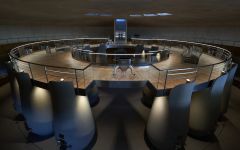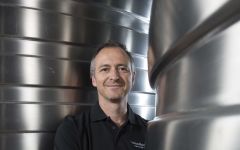Chateau Haut-Bailly 2010
- Decanter
-
Jeb
Dunnuck -
James
Suckling -
Wilfred
Wong -
Robert
Parker -
Wine
Enthusiast -
Wine
Spectator



Product Details
Your Rating
Somm Note
Winemaker Notes
The vintage promises to be powerful with very long ageing potential; it has a condensed complex structure sustained by a dazzling freshness, ideal concentration combined with superb maturity. 2010 has already earned its place among the greatest Bordeaux.
Blend: 62% Cabernet Sauvignon, 36% Merlot, 2% Cabernet Franc
Professional Ratings
-
Decanter
As ever when tasting the two together, the striking thing is the difference in character rather than quality between 2009 and 2010. This is tighter, more structured in its concentration, more broad shouldered, but still intensely impressive and full of pleasure. Neither are ready to go yet, but this feels like it will last longer, and feels extremely Haut-Bailly in spirit, with an elegant but complex personality, and a grip that doesn't make a big deal of its power but refuses to give up. Blackberry, bilberry, black chocolate and pencil. Harvest September 22 to October 14. Drinking Window 2020 - 2045
-
Jeb Dunnuck
Every bit as good yet in a dramatically different style, the 2010 Château Haut-Bailly has a more chiseled, focused, inward style to go with the essence of Haut-Bailly-like aromatics of sweet red and black fruit, smoked tobacco, graphite, and crushed stone, with just a hint of background minty herbs. It's full-bodied, perfectly balanced, has flawless tannins, and a rare mix of power, elegance, and purity. It blossoms with air, and while certainly mature, it has another 2-3 decades of overall longevity ahead of it.
-
James Suckling
Great aromas of crushed blackberries with flowers and stones that follow through to a full body, with super silky tannins and a long, long finish. It fills your mouth with beautiful fruit and velvety tannins yet shows tension and form. This lasts for minutes on the palate. Structured and superb. Don't touch until 2020.
-
Wilfred Wong of Wine.com
COMMENTARY: I have followed this wine for nearly two decades. Dutifully tasting vintage after vintage, and savoring the moments. The 2010 Château Haut-Bailey is a stunning wine, competing well with wines twice its price. TASTING NOTES: This wine is dynamic, compelling, and energetic. Its aromas and flavors of black fruits, violets, and oak accents should pair it superbly with a well-marbled ribeye. (Tasted: November 5, 2018, San Francisco, CA)
-
Robert Parker's Wine Advocate
The 2010 Haut Bailly has consistently been a fantastic wine, and at seven years of age I have no reason to alter that view. It has a mixture of red and black fruit on the nose, wet stone, black olive and a light marine influence. It is still backward compared to other vintages, but it has not relinquished one iota of its intensity. The palate is medium-bodied with fine tannin. This is a voluminous Haut Bailly, one that is beginning to stretch its muscles, with a gentle grip in the mouth with a wonderful saline finish. There is huge potential locked into this wine, but patience is needed. Tasted March 2017.
-
Wine Enthusiast
A powerful and complex wine from an estate performing on its top form. Solid tannins, layers of wood and dark fruits combine to give a wine that offers both richness and a dense structure. This Haut-Bailly should age impressively and for many years. Cellar Selection
-
Wine Spectator
Chewy and brambly, but integrated, this carries a very hefty core of espresso, ganache, mulled plum and blackberry fruit. The purity starts to shine through on the finish, which drips with cassis and is threaded with a long warm paving stone note. Tight and backward today, this extremely well-built wine will need substantial cellaring. Best from 2018 through 2035.
Other Vintages
2022-
Jeb
Dunnuck -
James
Suckling -
Robert
Parker - Decanter
-
James
Suckling - Decanter
-
Robert
Parker -
Jeb
Dunnuck
-
James
Suckling -
Jeb
Dunnuck -
Wine
Enthusiast -
Robert
Parker -
Wine
Spectator - Decanter
-
James
Suckling -
Wilfred
Wong - Decanter
-
Wine
Enthusiast -
Robert
Parker -
Jeb
Dunnuck
-
James
Suckling -
Jeb
Dunnuck - Decanter
-
Robert
Parker -
Wine
Enthusiast -
Wine
Spectator
-
Robert
Parker -
James
Suckling -
Jeb
Dunnuck -
Wine
Enthusiast - Decanter
-
Wine
Spectator
-
James
Suckling - Decanter
-
Robert
Parker -
Jeb
Dunnuck -
Wine
Enthusiast -
Wine
Spectator -
Connoisseurs'
Guide
-
Jeb
Dunnuck - Decanter
-
James
Suckling -
Wine
Enthusiast -
Robert
Parker -
Wine
Spectator
-
Wilfred
Wong -
James
Suckling -
Wine
Enthusiast -
Jeb
Dunnuck - Decanter
-
Wine
Spectator -
Robert
Parker
-
Jeb
Dunnuck -
Wilfred
Wong -
Wine
Enthusiast -
James
Suckling -
Robert
Parker -
Wine
Spectator
- Decanter
-
Wine
Enthusiast -
Robert
Parker -
James
Suckling -
Jeb
Dunnuck -
Wine
Spectator
-
Robert
Parker -
Jeb
Dunnuck - Decanter
-
James
Suckling -
Wine
Enthusiast -
Wine
Spectator
-
Robert
Parker -
Jeb
Dunnuck - Decanter
-
Wine
Enthusiast -
James
Suckling -
Wine
Spectator
- Decanter
-
Robert
Parker -
Wine
Spectator -
Jeb
Dunnuck
-
Jeb
Dunnuck - Decanter
-
Wine
Spectator -
Robert
Parker -
James
Suckling -
Wine
Enthusiast -
Connoisseurs'
Guide
- Decanter
-
Wine
Enthusiast -
Robert
Parker -
Jeb
Dunnuck -
Wine &
Spirits -
Wine
Spectator -
James
Suckling
-
James
Suckling - Decanter
-
Jeb
Dunnuck -
Robert
Parker
- Decanter
-
Jeb
Dunnuck -
Robert
Parker







The vineyard of Haut-Bailly as we know it today began to take shape when the Goyanèche and then the Daitze family acquired and unified the best vine growing plots in the 1530s. The estate remained in the Daitze Family until 1630 when it was purchased by Firmin Le Bailly and Nicolas de Leuvarde, wealthy Parisian bankers and lovers of Graves wines.
Following substantial investments, the property continued to be passed down the Bailly family line until 1736, when Irishman Thomas Barton took the helm. His strong business network allowed him to spread word about the quality of Chateau Haut-Bailly at a time when French ‘claret' was beginning its rise to stardom in England and Ireland.
Throughout the 18th century powerful, well-connected and ambitious owners drove Haut-Bailly to new heights, including Christophe Lafaurie de Monbadon and his son Laurent who went on to become Mayor of Bordeaux in 1805.
In 1872, Alcide Bellot des Minières acquired the estate and constructed the imposing, stone chateau building that remains to this day. He pioneered a precise, science-driven approach to viticulture, becoming a figure of legend widely known as the 'King of Vintners'. Thanks to Alcide's incredible drive, Haut-Bailly experienced a remarkable golden age, commanding the same prices as the First Growths: Lafite, Latour, Margaux and Haut-Brion.
The purchase of Haut-Bailly in 1955 by Daniel Sanders, a Belgian negociant, opened up a new era. Daniel and his son, Jean, recomposed the vineyard, renovated the winery and took pains to select only grapes from the best vines for their grand vin. They succeeded in giving the wines a unique style and reputation, and Haut-Bailly recovered its image as a great wine on the international marketplace.
In July 1998 Chateau Haut-Bailly was purchased by American Robert G. Wilmers, chairman and CEO of the M&T Bank based in Buffalo, New York. A lifelong lover of Bordeaux Grands Crus, Bob was behind every strategic decision, ensuring that Haut-Bailly followed a path of progression and continuity whilst remaining ever-respectful of its heritage.
After Mr. Wilmers purchased the property, he first asked Jean Sanders to stay on board, and then Véronique Sanders, fourth generation, to serve as general manager, overseeing a far-reaching investment programme to modernise the vineyards, cellars, offices, and chateau itself.
For Bob and his wife Elisabeth, Haut-Bailly went well beyond a financial investment: it was a joint passion. Following the sad passing of Bob in December 2017, his family has taken over and will continue in his footsteps. Together with the management team, they are committed to continuing Bob’s work in the same spirit and energy as in the past twenty years. The many recently initiated and future projects will be pursued.
With the 2021 vintage, Chateau Haut-Bailly debuted a contemporary, custom-built winery which was completed at the end of 2020. The building allows them to carry out precision work in optimal conditions thanks to the space, natural light and technical innovation which are at the heart of the project.
